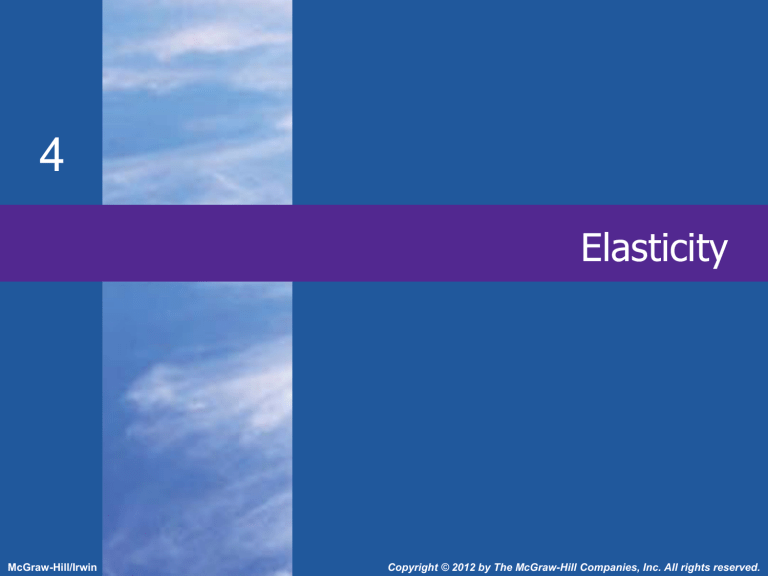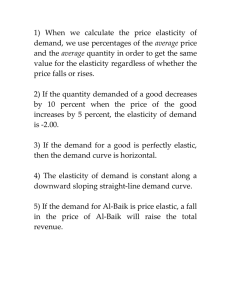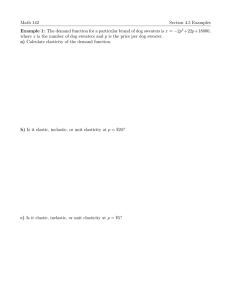
4
Elasticity
McGraw-Hill/Irwin
Copyright © 2012 by The McGraw-Hill Companies, Inc. All rights reserved.
Main Discussions
•
•
•
•
•
Price elasticity of demand
The total revenue test
Price elasticity of supply
Cross elasticity of demand
Income elasticity of demand
6-2
Price Elasticity of Demand
• Measures buyers’ responsiveness to
•
•
LO1
price changes
Elastic demand
• Sensitive to price changes
• Large change in quantity
Inelastic demand
• Insensitive to price changes
• Small change in quantity
Price Elasticity of Demand Formula
• Formula for price elasticity of demand
Percentage Change in Quantity
Demanded of Product X
Ed =
Percentage Change in Price
of Product X
LO1
Price Elasticity of Demand Formula
• Use the midpoint formula
• Ensures consistent results
Ed =
LO1
Change in quantity
Change in price
Sum of quantities/2 ÷ Sum of prices/2
Price Elasticity of Demand Formula
• Use percentages
• Unit free measure
• Compare responsiveness across
•
LO1
products
Eliminate the minus sign
• Easier to compare elasticities
Elasticity of Demand
(1)
Total Quantity of
Tickets Demanded
Per Week, Thousands
(2)
Price Per Ticket
1
$8
2
7
3
4
5
6
7
8
]
]
6
]
5
]
4
]
3
]
2
]
1
(3)
Elasticity
Coefficient (Ed)
]
]
]
]
]
]
]
6-7
Interpretation of Elasticity of Demand
• Ed > 1 demand is elastic
• Ed = 1 demand is unit elastic
• Ed < 1 demand is inelastic
• Extreme cases
• Perfectly inelastic
• Perfectly elastic
LO1
Extreme Cases
P
D1
Perfectly
inelastic
demand
(Ed = 0)
0
Perfectly inelastic demand
LO1
Extreme Cases
P
D2
Perfectly
elastic
demand
(Ed = ∞)
0
Perfectly elastic demand
LO1
Total Revenue Test
• Total Revenue = Price X Quantity
• Inelastic demand
• P and TR move in the same direction
• Elastic demand
• P and TR move in opposite directions
LO2
Total Revenue Test
• Lower price and elastic demand
• Blue gain exceeds orange loss
P
$3
a
2
b
1
D1
0
LO2
10
20
30
40
Q
Total Revenue Test
• Lower price and inelastic demand
• Orange loss exceeds blue gain
P
$4
c
3
2
d
1
D2
0
LO2
10
20
Q
Total Revenue Test
• Lower price and unit elastic demand
• Blue gain equals orange loss
P
$3
e
2
f
1
D3
0
LO2
10
20
30
Q
Total Revenue Test
Price Elasticity of Demand for Movie Tickets as Measured by the Elasticity
Coefficient and the Total-Revenue Test
(1)
Total Quantity of
Tickets Demanded per
Week, Thousands
(2)
Price per Ticket
1
$8
2
7
5.00
14,000
Elastic
3
6
2.60
18,000
Elastic
4
5
1.57
20,000
Elastic
5
4
1.00
20,000
Unit Elastic
6
3
0.64
18,000
Inelastic
7
2
0.38
14,000
Inelastic
8
1
0.20
8,000
Inelastic
LO2
(3)
Elasticity
Coefficient
(Ed)
(4)
Total
Revenue
(1) X (2)
(5)
Total
Revenue
Test
$8,000
Price
Elasticity and Total Revenue
$8
7 a
b
6
c
5
4
d
e
3
2
f
g
1
Elastic
Ed > 1
Unit Elastic
Ed = 1
Inelastic
Ed < 1
h
D
0 1 2 3 4 5 6 7 8
Total Revenue
(Thousands of Dollars)
Quantity Demanded
$20
18
16
14
12
10
8
6
4
2
TR
0 1 2 3 4 5 6 7 8
Quantity Demanded
LO2
Summary of Price Elasticity of Demand
Price Elasticity of Demand: A Summary
Absolute Value
of Elasticity
Coefficient
Demand Is:
Impact on Total Revenue of a:
Description
Price Increase Price Decrease
Qd changes by a
larger
percentage than
does price
Total Revenue
decreases
Total Revenue
increases
Greater than 1
(Ed > 1)
Elastic or
relatively
elastic
Equal to 1
(Ed = 1)
Unit or unitary Qd changes by
elastic
the same
percentage as
does price
Total revenue
is unchanged
Total revenue
is unchanged
Less than 1
(Ed < 1)
Inelastic or
relatively
inelastic
Total revenue
increases
Total revenue
decreases
LO2
Qd changes by a
smaller
percentage than
does price
Determinants of Elasticity of Demand
• Substitutability
•
• More substitutes, demand is more elastic
Proportion of Income spent
• Higher proportion of income spent on the
product, demand is more elastic
• Luxuries vs. Necessities
•
• Necessity goods- demand is more inelastic
Time
• Longer time available for consumers, demand
is more elastic
LO1
Price Elasticity of Demand
Selected Price Elasticities of Demand
Product or Service
Price Elasticity
of Demand (Ed) Product or Service
Price Elasticity
of Demand (Ed)
Newspapers
.10
Milk
.63
Electricity (household)
.13
Household appliances
.63
Bread
.15
Liquor
.70
MLB Tickets
.23
Movies
.87
Telephone Service
.26
Beer
.90
Cigarettes
.25
Shoes
.91
Sugar
.30
Motor vehicles
1.14
Medical Care
.31
Beef
1.27
Eggs
.32
China, glassware
1.54
Legal Services
.37
Residential land
1.60
Automobile repair
.40
Restaurant meals
2.27
Clothing
.49
Lamb and mutton
2.65
Gasoline
.60
Fresh peas
2.83
LO1
Applications of Ed
• Large Crop Yields
• Inelastic demand for food items- lower
total revenue for farmers
• Excise Taxes
• Inelastic demand- increase taxes leads
to more tax revenues
LO1
Price Elasticity of Supply
• Measures sellers’ responsiveness to
price changes
• Elastic supply, producers are
responsive to price changes
• Inelastic supply, producers are not
responsive to price changes
LO3
Price Elasticity of Supply
• Formula to compute elasticity
• Es > 1 supply is elastic
• Es < 1 supply is inelastic
Es =
LO3
Percentage Change in Quantity
Supplied of Product X
Percentage Change in Price
of Product X
Price Elasticity of Supply
• Time is primary determinant of
•
LO3
elasticity of supply
Time periods considered
• Market period
• Short Run
• Long Run
Elasticity of Supply: The Market Period
• Perfectly inelastic supply
P
Sm
Pm
P0
D2
D1
Q0
LO3
Q
Elasticity of Supply: The Short Run
• Supply is more elastic than in market
period
P
Ss
Ps
P0
D2
D1
Q0 Qs
LO3
Q
Elasticity of Supply: The Long Run
• Supply is even more elastic than in
the short run
P
Sl
Pl
P0
D2
D1
Q0
LO3
Ql
Q
Applications of Elasticity of Supply
• Antiques- inelastic supply;
•
•
LO3
sharp differences in the
price depending on
demand
Reproductions of antiquesmore elastic supply
Gold prices- volatile due to
inelastic supply and
fluctuating demand
Cross Elasticity of Demand
• Measures responsiveness of sales to
•
•
•
change in the price of another good
Substitutes – positive sign
Complements – negative sign
Independent goods - zero
Percentage change in quantity demanded of product X
Ex,y =
Percentage change in price of product Y
LO4
Cross Elasticity of Demand
• Application
• Change the price of a product? Will
•
LO4
it have Any impact to the sales of
other related products?
Allow a merger? Will it reduce
competition and create a
monopoly?
Income Elasticity of Demand
• Measures responsiveness of buyers
•
•
to changes in income
Normal goods – positive sign
Inferior goods – negative sign
Percentage change
in quantity demanded
Ei =
Percentage change in income
LO4
Income Elasticity Insights
• High income elasticities
• Most affected by a recession
• Low income elasticities
• Least affected by a recession
• Negative income elasticities
• Sales increase during a recession
LO4
Ex,y and Ei
Cross and Income Elasticities of Demand
Value of
Coefficient
Cross elasticity:
Positive (Ewz > 0)
Negative (Exy < 0)
Description
Quantity demanded of W changes in same
direction as change in price of Z
Type of Good(s)
Substitutes
Quantity demanded of X changes in
Complements
opposite direction from change in price of Y
Income elasticity:
Positive (Ei >0)
Quantity demanded of the product changes
in same direction as change in income
Normal or superior
Negative (Ei<0)
Quantity demanded of the product changes
in opposite direction from change in income
Inferior
LO4
Elasticity and Pricing Power
• Charge different prices based on
•
price elasticities
Examples:
• Business air travelers
• Adult vs. child
• Practice of price discriminationcharging different prices without
any differences in costs







